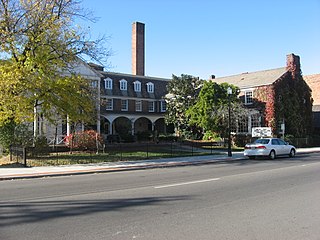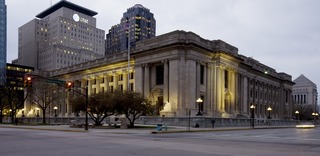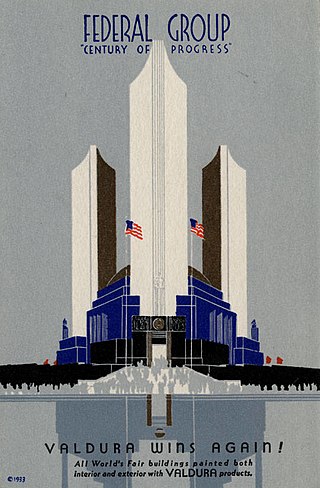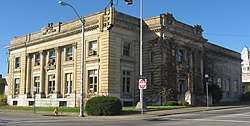
Zanesville is a city in and the county seat of Muskingum County, Ohio, United States. Located at the confluence of the Licking and Muskingum rivers, the city is approximately 52 miles (84 km) east of Columbus and had a population of 24,765 as of the 2020 census, down from 25,487 as of the 2010 census. Historically the state capital of Ohio from 1810 to 1812, Zanesville anchors the Zanesville micropolitan area and is part of the greater Columbus-Marion-Zanesville combined statistical area.
Old Post Office, or Former Post Office, may refer to:
The Office of the Supervising Architect was an agency of the United States Treasury Department that designed federal government buildings from 1852 to 1939.

Ohio Drive is a street in Southwest Washington, D.C., located in East and West Potomac Parks and bordering the Tidal Basin, Washington Channel, and the Potomac River. It is a central organizing feature of East Potomac Park, providing the only major vehicular route to and through the area. Unlike most roadways named after states in the District of Columbia, Ohio Drive is not an avenue, nor it is heavily used like Wisconsin or Rhode Island Avenues. However, the segment from Independence Avenue to the Rock Creek and Potomac Parkway is an important commuter route.

This is a list of the National Register of Historic Places listings in Cuyahoga County, Ohio.

Coal Run is an unincorporated community in northeastern Waterford Township, Washington County, Ohio, United States. It has a post office with the ZIP code 45721. It is located along State Route 60 between the villages of Beverly and Lowell. The Muskingum River flows past the community.

Arnold William Brunner was an American architect who was born and died in New York City. Brunner was educated in New York and in Manchester, England. He attended the Massachusetts Institute of Technology, where he studied under William R. Ware. Early in his career, he worked in the architectural office of George B. Post. He was a Fellow of the American Institute of Architects after 1892 and was appointed by Theodore Roosevelt to the United States Commission of Fine Arts in Washington, D.C. He was a member of the New York Fine Arts Commission, the American Civic Association, The Century Association, The Engineer's Club, The Players, the Cosmos Club in Washington D.C., the National Institute of Arts and Letters, The Union Club of Cleveland, and several other organizations. In 1910, he was elected to the National Academy of Design as an Associate member, and became a full member in 1916. Brunner was also known as a city planner, and made significant contributions to the city plans of Cleveland, Ohio, Rochester, New York, Baltimore, Maryland, Denver, Colorado, Trenton, New Jersey, and Albany, New York. Brunner was, for a short time, partnered with Thomas Tryon as the firm Brunner & Tryon.

The Adena Court Apartments are an apartment building in downtown Zanesville, Ohio, United States. Built in 1906, the apartments are a well-preserved example of the Colonial Revival style of architecture of the early twentieth century.

The Arlington Hotel was a historic hotel along U.S. Route 40 in Zanesville, Ohio, United States. Built in 1883 in the Italianate style, it was listed on the National Register of Historic Places in 1982. It has since been demolished.

The former Zanesville YWCA, located at 49 North 6th Street in Zanesville, Ohio, United States, is an historic building built in 1926 for members of the Young Women's Christian Association. It was designed by Howell & Thomas. On July 17, 1978, it was added to the National Register of Historic Places. It is now Bryan Place.
William H. Nicklas (1866–1960) was an Ohio architect who was best known for his church designs in partnership with Sidney Badgley.

James Knox Taylor was Supervising Architect of the United States Department of the Treasury from 1897 to 1912. His name is listed ex officio as supervising architect of hundreds of federal buildings built throughout the United States during the period.
Federal Building and Post Office, and variations such as prefixed by Old, may refer to:

The Birch Bayh Federal Building and U.S. Courthouse, formerly known as the U.S. Courthouse and Post Office and as the Federal Building, is a courthouse of the United States District Court for the Southern District of Indiana, located in Indianapolis. It is a distinguished example of Beaux-Arts architecture, and was listed in the National Register of Historic Places in 1974. Constructed from 1902 to 1905, the United States District Court for the District of Indiana met here until it was subdivided in 1928; the United States Circuit Court for the District of Indiana met here until that court was abolished in 1912. It was listed on the National Register of Historic Places as "U.S. Courthouse and Post Office" in 1974. The courthouse was renamed in honor of Senator Birch Bayh in 2003.

The Howard M. Metzenbaum U.S. Courthouse is a historic courthouse and post office building located on Superior Avenue in downtown Cleveland, Cuyahoga County, Ohio. Its west side faces Public Square and its north side faces The Mall. It was formerly the Federal Building and U.S. Courthouse and also known as Old Federal Building and Post Office.

The United States Post Office and Courthouse is a historic building in Downtown Columbus, Ohio. The structure was built from 1884 to 1887 as the city's main post office. The building also served as a courthouse of the United States District Court for the Southern District of Ohio from its completion in 1887 until 1934, when the court moved to the Joseph P. Kinneary United States Courthouse. The building was tripled in size from 1907 to 1912, and was rehabilitated for use as the Bricker & Eckler law offices in 1986, and today houses the same law firm.

The Joseph P. Kinneary United States Courthouse is a federal courthouse in Columbus, Ohio, in the city's downtown Civic Center. It was formerly known as the U.S. Post Office and Court House. It was designed by Richards, McCarty & Bulford and was completed in 1934. The supervising architect was James A. Wetmore. It was renamed for Joseph P. Kinneary in 1998. It is still in use by the U.S. District Court for the Southern District of Ohio.

Federal buildings in the United States house offices of the United States government that provide services to state and city level population centers. These federal buildings are often literally named Federal Building, with this moniker displayed on the property; they may share real estate with federal courthouses.

















